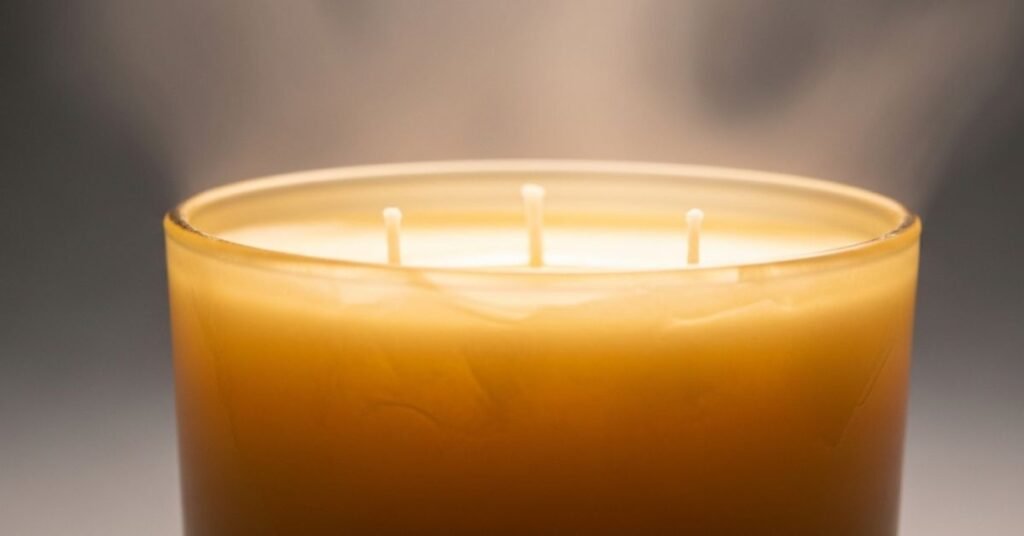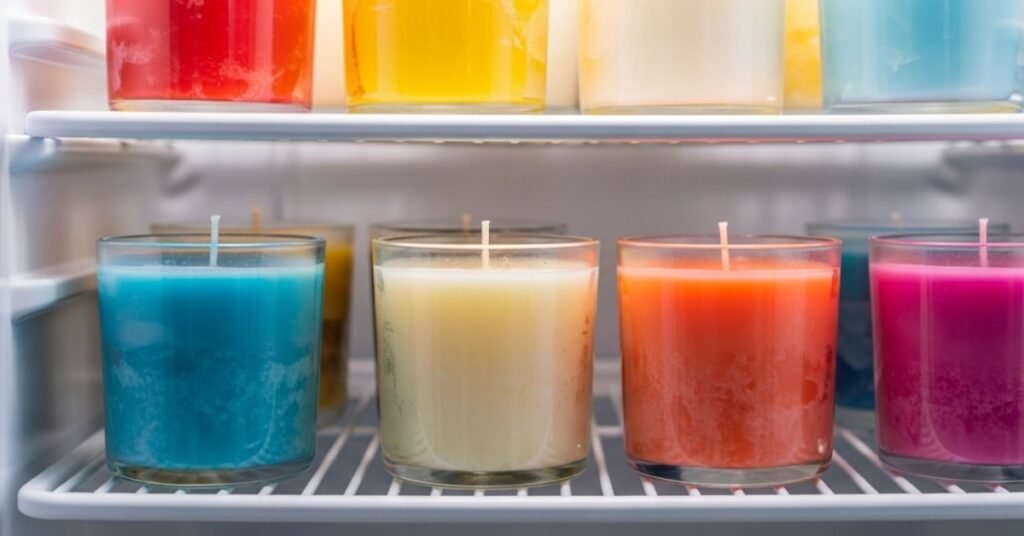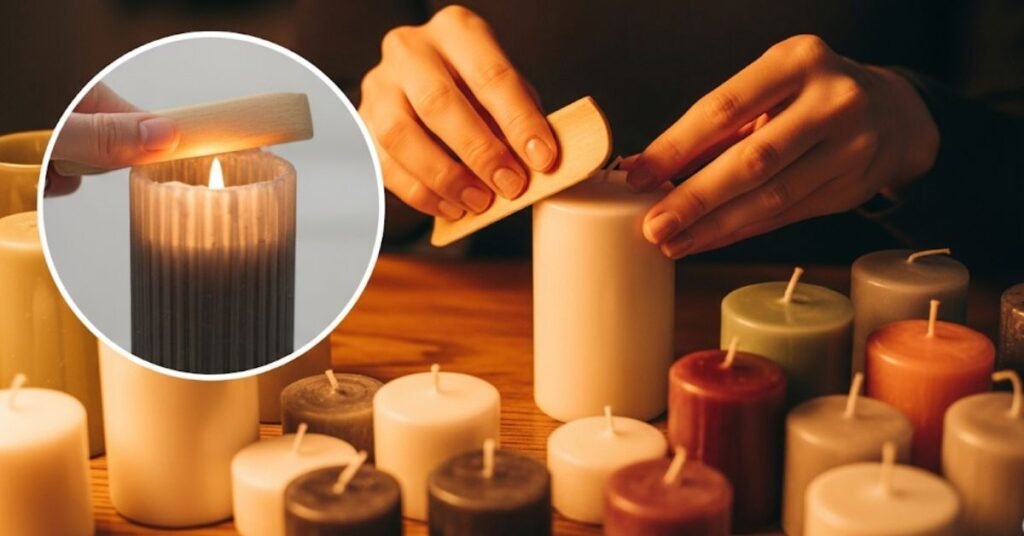✅ Use a water bath – Helps cool and set candles faster with a smoother finish.
✅ Refrigerate after partial cooling – Speeds up hardening and helps with mold release (avoid freezing).
✅ Use a fan for indirect airflow – Promotes even cooling without drafts.
❌ Avoid freezing candles – Can cause cracks, frosting, or warping.
⏳ Still allow a few days to cure – For proper scent throw and burn quality.
To learn more about how to speed up candle curing time, be sure to check out the detailed guide below.
How to Speed Up Candle Curing Time: Effective Techniques
If you’ve ever waited (impatiently) for your freshly poured candles to be ready, you’re not alone. Candle curing is essential it’s what transforms your wax and fragrance into a beautiful, even-burning candle with strong scent throw. But is there a safe way to speed up the process? The answer is yes with some smart strategies and a little patience.
1. Use a Warm, Stable Environment
One of the most effective ways to help your candles cure a bit faster is by placing them in a consistently warm room, ideally around 75–80°F (24–27°C). This encourages the wax to stabilize more efficiently. Just make sure the space is away from direct sunlight or extreme heat, which could cause the fragrance to evaporate or the wax to sweat.
2. Cure Without Lids (Carefully)
Leaving the lids off during curing can help with airflow and slightly speed up the process. However, be cautious fragrance oils can evaporate more quickly if left uncovered for too long. If you try this method, do so in a clean, dust-free environment and monitor how your candles respond.
3. Make Smaller Candles for Faster Curing
Smaller candles naturally cool and cure faster because there’s less wax to stabilize. If you’re in a rush say for an event, gift, or customer order opting for tin containers or votives over large jars might shave days off the process.
4. Control Your Workspace Humidity
Humidity can quietly sabotage your curing process. High moisture levels in the air slow down the crystallization that happens in wax as it sets. If you’re in a humid climate, using a dehumidifier or setting your candles in a controlled room (ideally 50–60% humidity) can speed things up and improve consistency.
5. Don’t Refrigerate It’s Not Worth It
While it might seem like a shortcut, refrigerating candles can actually harm their structure. Condensation can form, leading to cracking or wet spots that affect burn quality and appearance. Let your candles cure at room temperature for best results.
🔥 Quick Tip: Paraffin wax candles cure the fastest usually within 24–48 hours. Soy wax typically takes 1–2 weeks, while beeswax can need up to 4 weeks. Choose your wax type based on your timeline and fragrance needs.

Final Word: Test, Don’t Guess
Even if you use every method to speed up curing, testing is non-negotiable. A proper burn test will tell you whether your candle is ready look for strong scent throw, even burning, and solid wax throughout. Curing is as much art as science, and with experience, you’ll find the balance that works best for your space and your products.
If you’re crafting candles to sell, gift, or enjoy at home, knowing how to safely speed up curing gives you more control and more confidence in the final result.
How Can I Understand What Candle Curing Really Is?
Candle curing is the process of allowing freshly poured candles to rest, letting the wax solidify and the fragrance integrate fully. This step ensures your candles burn evenly and release a strong, consistent scent. Here’s a breakdown of what happens during curing:
- Solidification Phase: The wax cools from liquid to solid, visible as it hardens from the outside in.
- Crystallization Phase: The wax forms a crystalline lattice that traps fragrance molecules, stabilizing the scent. This phase, often complete within 48 hours, is crucial for optimal performance, according to Candle Shack BV.
Different waxes have unique curing needs:
- Paraffin Wax: Cures in 24-48 hours due to its quick stabilization.
- Soy Wax: Requires 1-2 weeks for full fragrance integration.
- Beeswax: Takes 1-4 weeks, depending on fragrance load.
- Gel Wax: Needs 2-3 days, though fragrances may extend this.
Understanding curing helps you appreciate why patience is key. Rushing this process can lead to weak scents or uneven burns, which is critical for DIY makers and business owners aiming to impress customers with artisanal candles.
Why Should I Care About Curing My Candles Properly?
Proper curing is essential for creating candles that stand out, whether you’re gifting them or selling to boutique stores. Here’s why it matters:
- Enhanced Scent Throw: Curing allows fragrance oils to meld with the wax, ensuring a strong, consistent scent when burned.
- Even Burning: Fully cured candles burn smoothly, avoiding tunneling (where only the center burns).
- Vibrant Colors: For dyed candles, curing stabilizes the color, keeping it bright and true.
- Customer Satisfaction: High-quality candles delight customers, whether they’re gift shoppers or event planners. Poorly cured candles with weak scents can lead to disappointment.
- Brand Reputation: For small business owners, quality candles reflect your craftsmanship, setting you apart in the competitive USA market.
Failing to cure properly risks:
- Weak scent throw, reducing appeal.
- Uneven burns, frustrating users.
- Muted colors in dyed candles, affecting aesthetics.
What Are the Standard Curing Times for Different Waxes?
Curing times vary by wax type, impacting how long you need to wait before burning or selling your candles. Here’s a detailed list:
| Wax Type | Curing Time | Notes |
|---|---|---|
| Paraffin Wax | 24-48 hours | Stabilizes quickly, ideal for fast turnaround (MakeSy). |
| Soy Wax | 1-2 weeks | Needs longer curing for strong scent throw (CandleScience). |
| Beeswax | 1-4 weeks | Varies with fragrance; heavier scents need more time (Craft Server). |
| Gel Wax | 2-3 days | Faster curing, but fragrances may require extra time (The Wax Chandler). |
These times are baselines. Factors like fragrance oil concentration or additives can extend curing. For example, high-fragrance candles may need additional time to ensure even scent distribution. Always test your candles to confirm they’re ready.
Can I Use a Fridge to Speed Up Candle Curing?
Using a fridge to speed up curing is not advisable. Here’s why:
- Thermal Shock: Sudden cold exposure after pouring hot wax can cause the wax to crack or split, ruining the candle’s appearance.
- Condensation: Cold temperatures can lead to moisture buildup on the candle’s surface, affecting fragrance and aesthetics.
- Uneven Curing: Rapid cooling may solidify the outer wax but leave the inner wax uncured, leading to poor scent throw and burn issues.
Instead, opt for room-temperature curing in a controlled environment. If you need faster results, use a warm room or smaller containers, as these are safer and more effective, per Craft Server.

How Does Humidity Affect Candle Curing?
Humidity can significantly impact candle curing, especially in varied USA climates:
- High Humidity: Slows wax crystallization, potentially extending curing time. It may also weaken scent throw by affecting fragrance behavior.
- Low Humidity: Can speed up curing but risks faster fragrance evaporation, especially without lids.
To manage humidity:
- Cure candles in a room with 50-60% humidity, using a dehumidifier in humid areas or a humidifier in dry ones.
- Use lids to protect candles from excessive moisture or dryness.
- Check candles regularly for moisture spots or fragrance loss, adjusting as needed.
For example, in humid regions like the Southeast, a dehumidifier can help maintain consistent curing. In drier areas like the Southwest, lids can prevent fragrance loss. Controlling humidity ensures your candles cure effectively, delivering top-quality results.
What If I’m in a Rush: Quick Curing Tips for Last-Minute Gifts?
When you’re pressed for time and need candles ready for last-minute gifts, these strategies can help speed up curing while maintaining quality:
- Choose Paraffin Wax: Paraffin cures in 24-48 hours, much faster than soy (1-2 weeks) or beeswax (1-4 weeks), making it ideal for quick turnarounds, per MakeSy.
- Use a Warm Environment: Place candles in a stable 75-80°F room to accelerate wax stabilization. Avoid excessive heat to prevent fragrance loss, as advised by Highland Candle Company.
- Opt for Smaller Containers: Smaller candles cure faster due to less wax volume, perfect for event favors or small gifts.
- Cure Without Lids: Removing lids enhances air circulation, potentially speeding up curing, though it may risk slight fragrance dissipation, per NI Candle Supplies.
- Test Before Gifting: Always perform a burn test to check scent strength and burn quality to ensure your candles are ready.
Should I Cure My Candles with the Lids On or Off?
Deciding whether to cure candles with lids on or off depends on your goals for quality and speed:
- Lids On:
- Benefits: Protects candles from dust and debris, helping retain fragrance consistency, as noted by NI Candle Supplies.
- Drawbacks: May slow curing due to reduced air circulation, potentially extending the process slightly.
- Lids Off:
- Benefits: Increases air flow, which can speed up curing, especially for urgent projects.
- Drawbacks: Risks faster fragrance dissipation, which could weaken scent throw if not monitored.
For most candles, curing with lids on is best to preserve fragrance and protect the surface, especially for boutique owners aiming for premium quality. If you’re in a hurry, curing without lids can help, but test the candle to ensure the scent remains strong. Experiment with your wax and fragrance to find the best approach.
What Are the Risks of Not Curing Candles Long Enough?
Failing to cure candles properly can lead to several issues that affect performance and customer satisfaction:
- Weak Scent Throw: Fragrance oils may not fully integrate, resulting in a faint or inconsistent scent when burned, per Armatage Candle Company.
- Uneven Burning: Unstabilized wax can cause tunneling, where only the center burns, wasting wax and reducing burn time.
- Muted Colors: Dyed candles may appear streaky or faded if the wax hasn’t fully set, impacting aesthetics.
- Shorter Burn Time: Uncured candles may burn faster, disappointing users expecting longevity.
- Poor Customer Feedback: For gift shoppers or small businesses, subpar candles can lead to negative reviews, harming your reputation.
- These risks highlight why curing is critical, especially for USA-based event planners and boutique owners aiming to deliver high-quality, artisanal products.
How Can I Tell If My Candles Are Fully Cured?
To confirm your candles are fully cured, use these reliable methods:
- Burn Test: Light the candle and check for a strong, consistent scent and even burn. A fully cured candle should burn smoothly without tunneling, as recommended by Highland Candle Company.
- Visual Inspection: Ensure the wax is uniformly hard with no soft or liquid spots, especially in the center, indicating complete solidification.
- Time Verification: Confirm the recommended curing time for your wax has passed (e.g., 1-2 weeks for soy, 24-48 hours for paraffin).
Where Can I Find More Resources on Candle Making and Curing?
For comprehensive candle-making and curing resources, check out these trusted sources:
- Bath and Body Works Candles: My website offers expert tips, tutorials, and handcrafted candles for gifting, events, or personal use, perfect for USA-based candle lovers and businesses.
- CandleScience: Provides beginner-friendly guides and supplies for mastering candle making.
- Reddit: A community for sharing experiences and asking questions about curing and crafting.
- Highland Candle Company (Highland Candle Company): Offers practical advice on curing times and techniques.
How Can I Speed Up Candle Curing Time at Home?
To speed up candle curing at home without sacrificing quality, try these methods:
- Warm Environment: Place candles in a stable 75-80°F room to accelerate wax stabilization, avoiding excessive heat that could weaken fragrance, per Highland Candle Company.
- Enhance Air Circulation: Cure without lids to improve air flow, which can slightly speed up curing, though monitor for fragrance loss, as noted by NI Candle Supplies.
- Use Smaller Containers: Smaller candles cure faster due to less wax volume, ideal for quick home projects.
- Select Paraffin Wax: Paraffin cures in 24-48 hours, faster than soy or beeswax, per MakeSy.

How Long Should I Let My Candles Cure?
Curing times depend on the wax type, ensuring optimal scent and burn quality:
| Wax Type | Curing Time | Notes |
|---|---|---|
| Paraffin Wax | 24-48 hours | Stabilizes quickly, ideal for fast projects (MakeSy). |
| Soy Wax | 1-2 weeks | Needs longer for strong scent throw (CandleScience). |
| Beeswax | 1-4 weeks | Varies with fragrance load (Craft Server). |
| Gel Wax | 2-3 days | Faster curing, but fragrances may extend time (The Wax Chandler). |
Fragrance concentration or additives can extend curing, so test candles to confirm readiness. For best results, stick to the longer end of the range, especially for scented candles.
What Happens If I Burn My Candle Before It Cures?
Burning a candle before it’s fully cured can lead to disappointing results:
- Weak Scent: Fragrance oils may not be fully integrated, resulting in a faint or uneven scent, per Armatage Candle Company.
- Uneven Burn: Unstabilized wax can cause tunneling, leaving unused wax and reducing burn time.
- Muted Colors: Dyed candles may appear faded or streaky, impacting visual appeal.
- Shorter Burn Time: The candle may burn out faster than expected, disappointing users.
- Messy Performance: Soft wax can lead to overflow or a messy burn, affecting user experience.
These issues can harm your reputation, especially for gift shoppers or boutique owners, so always ensure proper curing for top-quality candles.
How Can I Tell If My Candle Is Cured?
To verify if your candle is fully cured, use these straightforward methods:
- Burn Test: Light the candle and assess the scent strength and burn pattern. A cured candle should have a strong, consistent scent and burn evenly without tunneling, per Highland Candle Company.
- Visual Check: Inspect the wax for uniform hardness. There should be no soft or liquid spots, especially in the center, indicating complete curing.
- Time Confirmation: Ensure the recommended curing time for your wax (e.g., 1-2 weeks for soy, 24-48 hours for paraffin) has passed.
These tests are crucial for DIY enthusiasts and small businesses to ensure candles meet high standards. If results are subpar, allow more curing time.
Final Thoughts For ‘How to Speed Up Candle Curing Time’
To wrap up, speeding up candle curing time is achievable with methods like using a warm environment, curing without lids, or choosing faster-curing waxes like paraffin. These techniques help you meet tight deadlines while maintaining quality. By testing your candles and following proper curing practices, you ensure strong scents and even burns that impress every time. Visit Bath and Body Works Candles to discover more candle-making tips and shop our artisanal candles for your next gift or event. Start crafting candles that shine today!
FAQs
How long does it take for a soy candle to cure?
Soy candles typically need 1-2 weeks to cure fully, ensuring optimal scent throw and burn quality. This allows the wax to stabilize and fragrance to integrate evenly.
Can I burn my candle immediately after it hardens?
No, burning too soon can result in weak scent throw and uneven burning. Wait the recommended curing time for your wax to ensure the best performance.
Does curing time affect the color of my candles?
Yes, proper curing stabilizes the color in dyed candles, preventing a streaky or faded appearance. This ensures vibrant, consistent hues.
Is there a way to tell if my candle is cured without burning it?
Visually inspect the wax for uniform hardness, especially in the center. A burn test remains the most reliable way to confirm curing.
Can I speed up the curing process for my candles?
Yes, place candles in a warm 75-80°F environment or cure without lids for better air circulation. Test afterward to ensure quality.